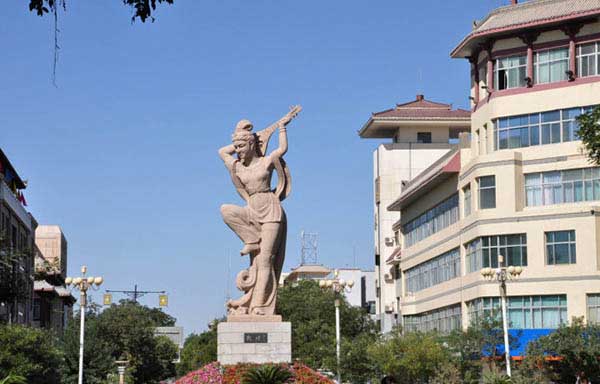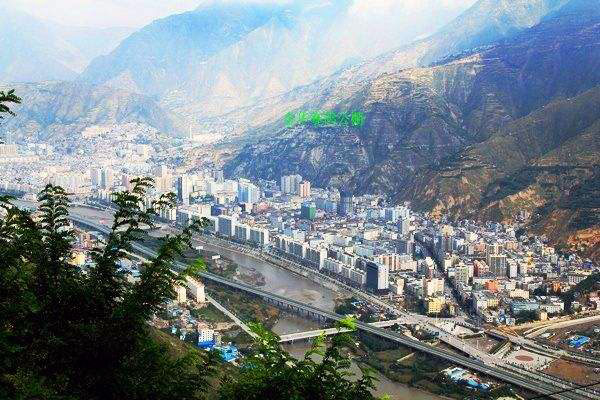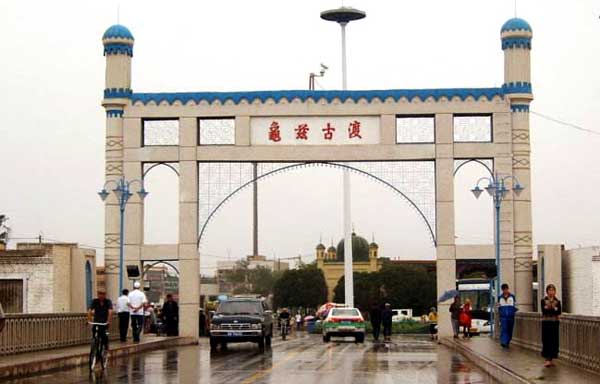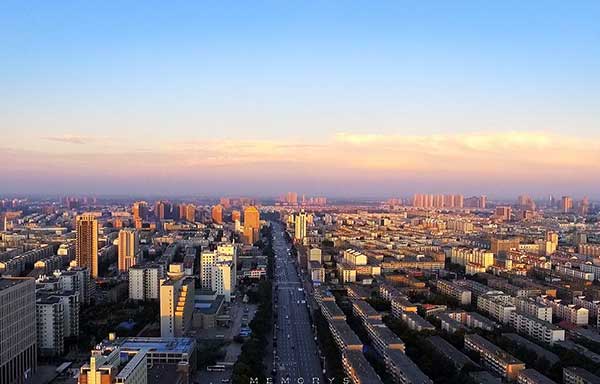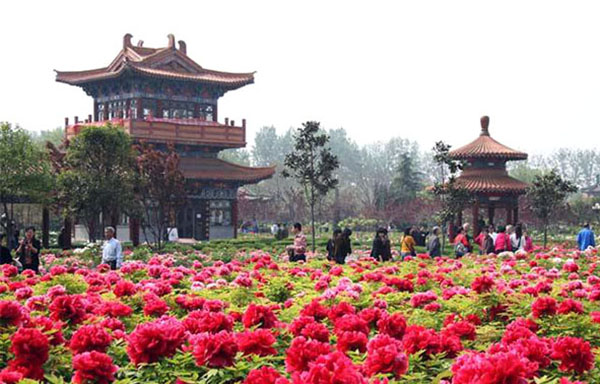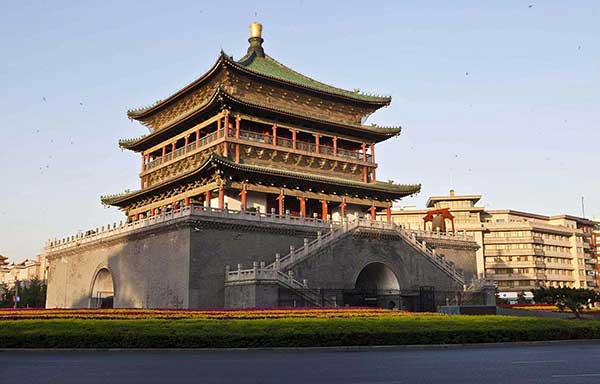- By admin
- In SilkRoadKnowledge
- 2024-04-29
Silk Road horses and camels
 Photograph of tomb wall painting
Photograph of tomb wall painting
featuring a Khitan horseman and his steed
Mid-Liao dynasty, c. 11th c
From Tomb #1 at Beisanjia Village Site
Aohan Banner, Chifeng Municipal District
This painting was found on the wall of a tomb located near the site of Shangjing, literally "Upper Capital," the central administrative city of the Liao dynasty. This tomb, known as Tomb #1, was discovered after it was partially exposed in the aftermath of an intense rain storm. It was created for the burial of a Khitan man and his wife (possibly the high official Xiao Quli, who married Zhigu, the daughter of the dynasty's founder Yelu Abaoji). Inscriptions dating the tomb to 959 make it the oldest of the Liao-era tombs excavated in Inner Mongolia.1 The tomb painting features a Khitan warrior leading his mount, and accompanied by a man of smaller stature, who appears to be beating a drum. The painting subject is dressed in a manner quite distinctive from contemporaneous Song aristocrats in his high boots and long tunic, along with his shaved pate and short plaits of hair descending from his temples. The image of both this man and his horse are well preserved. This fact, along with large amount of horse harnesses and fittings found among the over 2000 objects excavated from this site, give us a clear picture of the importance of horse-riding culture among the Khitan, as well as specific manner of equipment they utilized. The extremely high quality of the craftsmanship that went into making the fittings preserved in the tomb, along with the nature of the designs, indicate that most of the work was completed by Chinese craftsmen.
(1) This and all other information on Tomb #1 at Beisanjia included in this entry is taken from Adam T. Kessler, Empires Beyond the Great Wall: The Heritage of Genghis Khan (Los Angeles: Natural History Museum of Los Angeles County, 1993), p. 97.
This relationship between the rulers of China and the nomads who controlled the supply of horses continued down through the centuries to shape important aspects of the trade across Asia. At times the substantial financial resources of the Chinese empire were strained to keep frontiers secure and the essential supply of horses flowing. Silk was a form of currency; tens of thousands of bolts of the precious substance would be sent annually to the nomadic rulers in exchange for horses, along with other commodities (such as grain) which the nomads sought. Clearly not all that silk was being used by the nomads but was being traded to those further west. For a time in the eighth and early ninth centuries, the rulers of the T'ang Dynasty were helpless to resist the exorbitant demands of the nomadic Uighurs, who had saved the dynasty from internal rebellion and exploited their monopoly as the main suppliers of horses. Beginning in the Song Dynasty (11th-12th centuries), tea became increasingly important in Chinese exports, and over time bureaucratic mechanisms were developed to regulate the tea and horse trade. Government efforts to control the horse-tea trade with those who ruled the areas north of the Tarim Basin (in the Xinjiang of today) continued down into the sixteenth century, when it was disrupted by political disorders.
 Young Nobleman on Horseback
Young Nobleman on Horseback
by Qian Xuan (about 1235-1300)
Yuan dynasty, dated 1290
Handscroll: ink and polychrome on silk
Height: 29.7 cm
Width: 75.6 cm
Acquisition number: #OA 1954.12-11.05 (Chinese Painting Add. 286)
Gift of P.T. Brooke Sewell
Image courtesy of the British Museum (copyright reserved)
During the Yuan period, a dilemma faced the scholars and bureaucrats who had previously worked for the Song government. The Mongols distrusted these former officials, but at the same time, they had need of their administrative skills. Those that decided to serve under the invaders were often vilified in later histories, while those who refused to serve the Mongols were celebrated as yimin, "left-behind subjects," highly principled bureaucrats who preferred to live in obscurity and endure hardship rather than acknowledge the legitimacy of the Yuan dynastic reign.
Qian Xuan (c. 1235-after 1301) was one such yimin. He had garnered fame as a painter prior to the fall of the Song, and under Mongol rule he turned to his art in order to support himself. He painted a number of composition types, included landscapes, bird-and-flower paintings, and figure paintings intended to illustrate proper Confucian attitudes and behavior.
This composition features a young nobleman mounted on a horse, a common enough theme during the Yuan period; this painting, however, is rendered in a style reminiscent of earlier Six Dynasties period (220-589 CE). Many yimin artists explored archaic styles and motifs in a conscious effort to evoke the grandeur of a simpler and nobler time.
The presence of an inscription (not illustrated) by Zhao Mengfu (1254-1322), a literatus who served under the Mongols and rose high in the ranks of the Yuan court, makes for an interesting ideological dichotomy in a single work. The inscription reads:
Wuling is in the prime of youth, Energetic and restless, with white steed and golden saddle, He is in high spirits, Holding his bow he calls the oriole, but no oriole comes. Ancient catalpa1 and setting sun: what can be done about age? (translated by R. Whitfield)2
The best known example to illustrate the importance of the horse in the history of Inner Asia is the Mongol Empire. From modest beginnings in some of the best pasturelands of the north, the Mongols came to control much of Eurasia, largely because they perfected the art of cavalry warfare. The indigenous Mongol horses, while not large, were hardy, and, as contemporary observers noted, could survive in winter conditions because of their ability to find food under the ice and snow covering the steppes. It is important to realize though that the reliance on the horse was also a limiting factor for the Mongols, since they could not sustain large armies where there was not sufficient pasturage. Even when they had conquered China and established the Yuan Dynasty, they had to continue to rely on the northern pastures to supply their needs within China proper.
Related destinations
Why Choose Us?
We are the top Silk Road tour operator based in Dunhuang, China. We focus on providing well designed Silk Road China Tours with resonable price and thoughtful service.
- Easy & carefree booking
- The best value
- Great travel experience
- Locally operated
Hot Tours
-

6 days Gansu tour to Binglingsi, Xiahe and Langmusi
Tour type : Private tour Price : from *** Destinations : Lanzhou - linxia - Xiahe - Langmusi - Hezuo - Lanzhou -

12 Days Gansu Highlights Tour
Tour type : Private tour Price : from *** Destinations : Xian – Tianshui – Lanzhou – Xiahe – Langmusi – Hezuo – Zhangye – Jiayuguan - Dunhuang -

10 Days Silk Road Classic Tour
Tour type : Private tour Price : from *** Destinations : Xian - Zhangye - Jiayuguan - Dunhuang - Turpan - Urumqi -

5 Days Zhangye - Alxa youqi Highlights Tour
Tour type : Private Tour Price : from *** Destinations : Zhangye - Alax youqi - Zhangye

